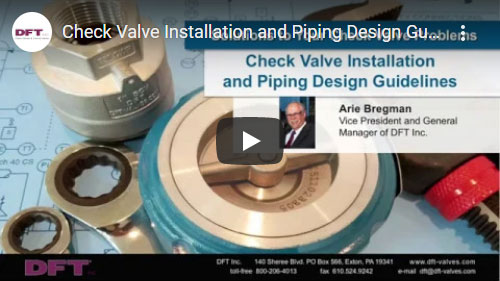DFT® Check Valves can be installed Horizontal, Vertical Flow up, or Vertical Flow Down
There are many different requirements when designing fluid flow systems and installing the correct check valves for the application. Not all styles of check valves function properly or are suitable for vertical flow directions. When installing a check valve, a horizontal line is always preferred, because it takes gravity out of the equation.
However, in real-world applications, the ideal situation is not always available. There are numerous applications where vertical runs are needed to move fluids either vertically up or down – such as within buildings, mine shafts, towers, etc. – for applications such as mine dewatering, sump pumps, and many others.
Why Swing Check Valves Don’t Work in Vertical Pipe Runs
If the flow in the vertical line is going upwards (against gravity), gravity will cause the disc to slam against the seat when the flow stops or a pump shuts down, leading to potentially severe water hammer. All that shock can be avoided with a DFT silent check valve.
The most difficult flow direction to address is vertical flow down. This flow direction is most often found in boiler supply lines and mining applications, where space is limited. A swing check valve will not work in this position as it will always be open and not doing its job.
Spring-Assisted Silent Check Valves for Vertical Flow Up or Down

Instead, a spring-assisted silent check valve is the ideal choice. In vertical piping the easiest thing to do is replace the swing check or double door valve with an inline, axial flow-style check valve. Only axial flow silent check valves perform well in vertical piping locations, as these valves rely on potential energy from a spring to close rather than on water pressure. This means that the valve will close on its own before any backed-up fluid can force its way back up into the piping.
The stronger spring of the axial flow valve will ensure that the valve closes before any reverse flow happens. Closing the valve before flow reverses will also eliminate most water hammer, which is the primary advantage of axial flow check valves.
DFT® Check Valves come in a large variety of styles, such as wafer, flanged, butt weld, and NPT. They are also available in a host of alloys and can be customized for most applications. Contact DFT for more information on which valve is appropriate for your specific piping design.
Custom Sizing for Your Specific Application

Whether it is used vertically or horizontally, DFT® can custom size a check valve to the unique requirements of your application. Given the known specifications of fluid type, specific gravity, pressure, flow rate, temperature, and more, we can custom engineer the check valve to suit your application.
To learn more about how DFT® Valves can improve fluid flow in your operation, please request a quote or contact us.














